BSB418: Develop and Apply Marketing Communications Workbook
VerifiedAdded on 2020/12/01
|9
|3664
|108
Homework Assignment
AI Summary
This assignment, a completed workbook for the BSB418 unit, delves into the marketing communications industry. It begins by defining various employment positions and their responsibilities within the marketing and communications sector, including roles such as Product Manager, Brand Manager, Marketing Manager, and CMO. The workbook then identifies and explains relevant legislation, specifically the Australian Consumer Law (ACL) concerning misleading conduct and false claims, and other employment obligations. It further outlines opportunities within the industry and analyzes the impact of six digital communication technologies (DCTs), including Social Media, Paid Media, SEO, Email, Cell Phones, and Virtual Reality, on marketing and communication strategies. The student provides brief descriptions and discusses the influence of each DCT on the industry, covering how each technology is used for marketing and its impact on reaching consumers.

BSBMKG418 Marketing Knowledge Workbook 2 Page 1 of 9
BSB418 Develop and Apply Knowledge of the
Marketing Communications Industry
Workbook 2 of 2
Name: _______________________
BSB418 Develop and Apply Knowledge of the
Marketing Communications Industry
Workbook 2 of 2
Name: _______________________
Paraphrase This Document
Need a fresh take? Get an instant paraphrase of this document with our AI Paraphraser
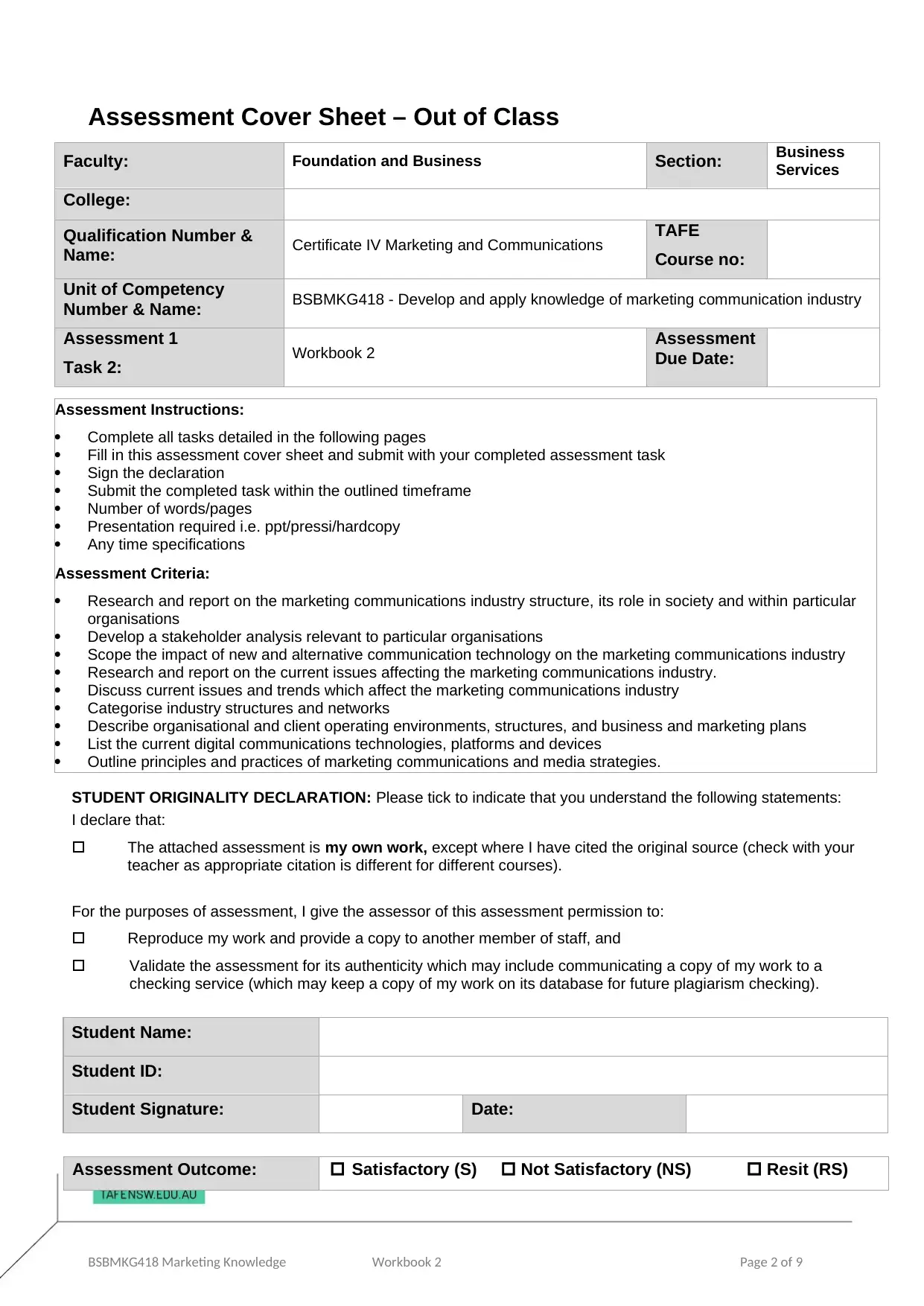
Assessment Cover Sheet – Out of Class
Faculty: Foundation and Business Section: Business
Services
College:
Qualification Number &
Name: Certificate IV Marketing and Communications TAFE
Course no:
Unit of Competency
Number & Name: BSBMKG418 - Develop and apply knowledge of marketing communication industry
Assessment 1
Task 2: Workbook 2 Assessment
Due Date:
Assessment Instructions:
Complete all tasks detailed in the following pages
Fill in this assessment cover sheet and submit with your completed assessment task
Sign the declaration
Submit the completed task within the outlined timeframe
Number of words/pages
Presentation required i.e. ppt/pressi/hardcopy
Any time specifications
Assessment Criteria:
Research and report on the marketing communications industry structure, its role in society and within particular
organisations
Develop a stakeholder analysis relevant to particular organisations
Scope the impact of new and alternative communication technology on the marketing communications industry
Research and report on the current issues affecting the marketing communications industry.
Discuss current issues and trends which affect the marketing communications industry
Categorise industry structures and networks
Describe organisational and client operating environments, structures, and business and marketing plans
List the current digital communications technologies, platforms and devices
Outline principles and practices of marketing communications and media strategies.
STUDENT ORIGINALITY DECLARATION: Please tick to indicate that you understand the following statements:
I declare that:
The attached assessment is my own work, except where I have cited the original source (check with your
teacher as appropriate citation is different for different courses).
For the purposes of assessment, I give the assessor of this assessment permission to:
Reproduce my work and provide a copy to another member of staff, and
Validate the assessment for its authenticity which may include communicating a copy of my work to a
checking service (which may keep a copy of my work on its database for future plagiarism checking).
Student Name:
Student ID:
Student Signature: Date:
Assessment Outcome: Satisfactory (S) Not Satisfactory (NS) Resit (RS)
BSBMKG418 Marketing Knowledge Workbook 2 Page 2 of 9
Faculty: Foundation and Business Section: Business
Services
College:
Qualification Number &
Name: Certificate IV Marketing and Communications TAFE
Course no:
Unit of Competency
Number & Name: BSBMKG418 - Develop and apply knowledge of marketing communication industry
Assessment 1
Task 2: Workbook 2 Assessment
Due Date:
Assessment Instructions:
Complete all tasks detailed in the following pages
Fill in this assessment cover sheet and submit with your completed assessment task
Sign the declaration
Submit the completed task within the outlined timeframe
Number of words/pages
Presentation required i.e. ppt/pressi/hardcopy
Any time specifications
Assessment Criteria:
Research and report on the marketing communications industry structure, its role in society and within particular
organisations
Develop a stakeholder analysis relevant to particular organisations
Scope the impact of new and alternative communication technology on the marketing communications industry
Research and report on the current issues affecting the marketing communications industry.
Discuss current issues and trends which affect the marketing communications industry
Categorise industry structures and networks
Describe organisational and client operating environments, structures, and business and marketing plans
List the current digital communications technologies, platforms and devices
Outline principles and practices of marketing communications and media strategies.
STUDENT ORIGINALITY DECLARATION: Please tick to indicate that you understand the following statements:
I declare that:
The attached assessment is my own work, except where I have cited the original source (check with your
teacher as appropriate citation is different for different courses).
For the purposes of assessment, I give the assessor of this assessment permission to:
Reproduce my work and provide a copy to another member of staff, and
Validate the assessment for its authenticity which may include communicating a copy of my work to a
checking service (which may keep a copy of my work on its database for future plagiarism checking).
Student Name:
Student ID:
Student Signature: Date:
Assessment Outcome: Satisfactory (S) Not Satisfactory (NS) Resit (RS)
BSBMKG418 Marketing Knowledge Workbook 2 Page 2 of 9
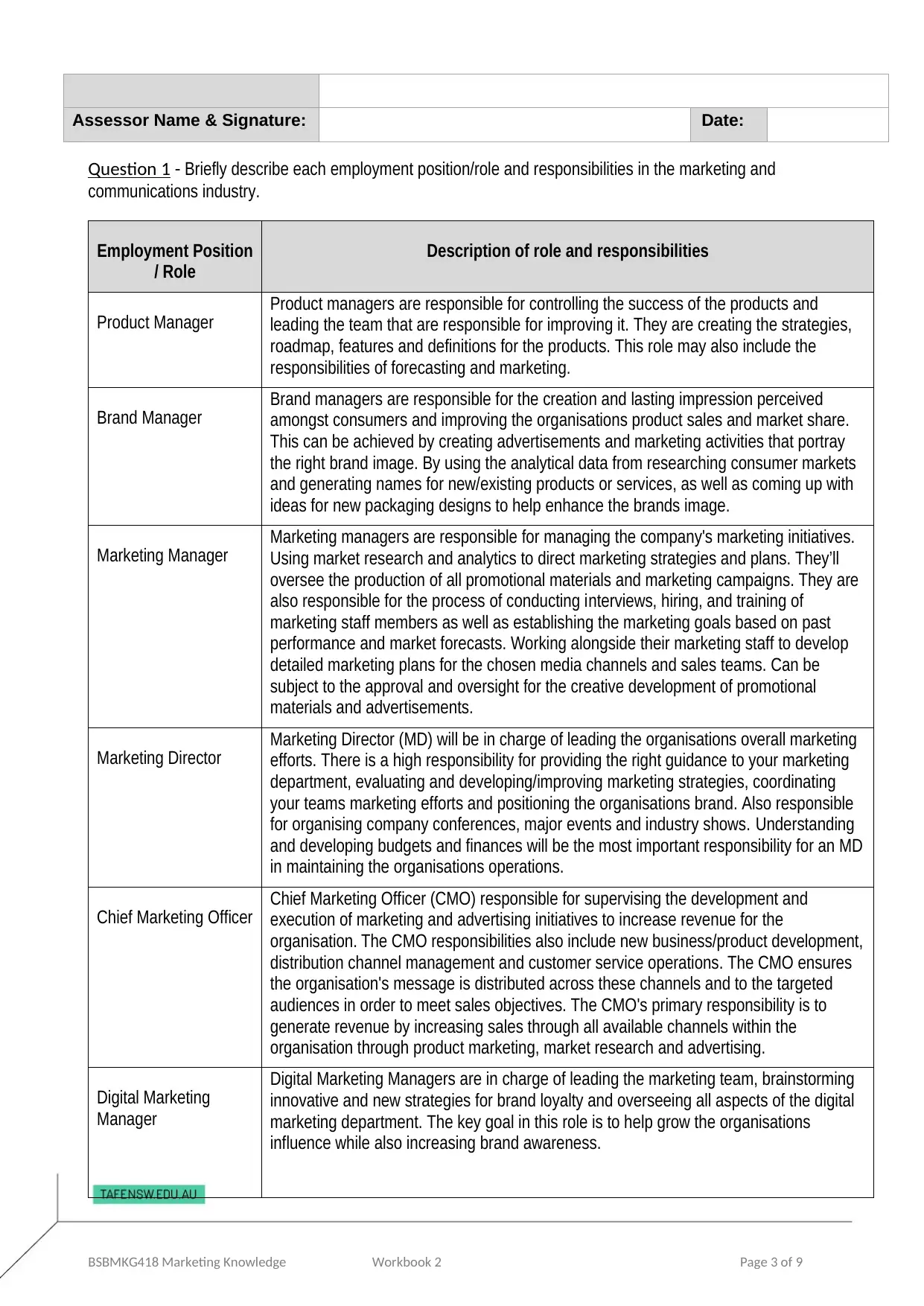
Assessor Name & Signature: Date:
Question 1 - Briefly describe each employment position/role and responsibilities in the marketing and
communications industry.
Employment Position
/ Role
Description of role and responsibilities
Product Manager Product managers are responsible for controlling the success of the products and
leading the team that are responsible for improving it. They are creating the strategies,
roadmap, features and definitions for the products. This role may also include the
responsibilities of forecasting and marketing.
Brand Manager Brand managers are responsible for the creation and lasting impression perceived
amongst consumers and improving the organisations product sales and market share.
This can be achieved by creating advertisements and marketing activities that portray
the right brand image. By using the analytical data from researching consumer markets
and generating names for new/existing products or services, as well as coming up with
ideas for new packaging designs to help enhance the brands image.
Marketing Manager Marketing managers are responsible for managing the company's marketing initiatives.
Using market research and analytics to direct marketing strategies and plans. They’ll
oversee the production of all promotional materials and marketing campaigns. They are
also responsible for the process of conducting interviews, hiring, and training of
marketing staff members as well as establishing the marketing goals based on past
performance and market forecasts. Working alongside their marketing staff to develop
detailed marketing plans for the chosen media channels and sales teams. Can be
subject to the approval and oversight for the creative development of promotional
materials and advertisements.
Marketing Director Marketing Director (MD) will be in charge of leading the organisations overall marketing
efforts. There is a high responsibility for providing the right guidance to your marketing
department, evaluating and developing/improving marketing strategies, coordinating
your teams marketing efforts and positioning the organisations brand. Also responsible
for organising company conferences, major events and industry shows. Understanding
and developing budgets and finances will be the most important responsibility for an MD
in maintaining the organisations operations.
Chief Marketing Officer Chief Marketing Officer (CMO) responsible for supervising the development and
execution of marketing and advertising initiatives to increase revenue for the
organisation. The CMO responsibilities also include new business/product development,
distribution channel management and customer service operations. The CMO ensures
the organisation's message is distributed across these channels and to the targeted
audiences in order to meet sales objectives. The CMO's primary responsibility is to
generate revenue by increasing sales through all available channels within the
organisation through product marketing, market research and advertising.
Digital Marketing
Manager
Digital Marketing Managers are in charge of leading the marketing team, brainstorming
innovative and new strategies for brand loyalty and overseeing all aspects of the digital
marketing department. The key goal in this role is to help grow the organisations
influence while also increasing brand awareness.
BSBMKG418 Marketing Knowledge Workbook 2 Page 3 of 9
Question 1 - Briefly describe each employment position/role and responsibilities in the marketing and
communications industry.
Employment Position
/ Role
Description of role and responsibilities
Product Manager Product managers are responsible for controlling the success of the products and
leading the team that are responsible for improving it. They are creating the strategies,
roadmap, features and definitions for the products. This role may also include the
responsibilities of forecasting and marketing.
Brand Manager Brand managers are responsible for the creation and lasting impression perceived
amongst consumers and improving the organisations product sales and market share.
This can be achieved by creating advertisements and marketing activities that portray
the right brand image. By using the analytical data from researching consumer markets
and generating names for new/existing products or services, as well as coming up with
ideas for new packaging designs to help enhance the brands image.
Marketing Manager Marketing managers are responsible for managing the company's marketing initiatives.
Using market research and analytics to direct marketing strategies and plans. They’ll
oversee the production of all promotional materials and marketing campaigns. They are
also responsible for the process of conducting interviews, hiring, and training of
marketing staff members as well as establishing the marketing goals based on past
performance and market forecasts. Working alongside their marketing staff to develop
detailed marketing plans for the chosen media channels and sales teams. Can be
subject to the approval and oversight for the creative development of promotional
materials and advertisements.
Marketing Director Marketing Director (MD) will be in charge of leading the organisations overall marketing
efforts. There is a high responsibility for providing the right guidance to your marketing
department, evaluating and developing/improving marketing strategies, coordinating
your teams marketing efforts and positioning the organisations brand. Also responsible
for organising company conferences, major events and industry shows. Understanding
and developing budgets and finances will be the most important responsibility for an MD
in maintaining the organisations operations.
Chief Marketing Officer Chief Marketing Officer (CMO) responsible for supervising the development and
execution of marketing and advertising initiatives to increase revenue for the
organisation. The CMO responsibilities also include new business/product development,
distribution channel management and customer service operations. The CMO ensures
the organisation's message is distributed across these channels and to the targeted
audiences in order to meet sales objectives. The CMO's primary responsibility is to
generate revenue by increasing sales through all available channels within the
organisation through product marketing, market research and advertising.
Digital Marketing
Manager
Digital Marketing Managers are in charge of leading the marketing team, brainstorming
innovative and new strategies for brand loyalty and overseeing all aspects of the digital
marketing department. The key goal in this role is to help grow the organisations
influence while also increasing brand awareness.
BSBMKG418 Marketing Knowledge Workbook 2 Page 3 of 9
⊘ This is a preview!⊘
Do you want full access?
Subscribe today to unlock all pages.

Trusted by 1+ million students worldwide
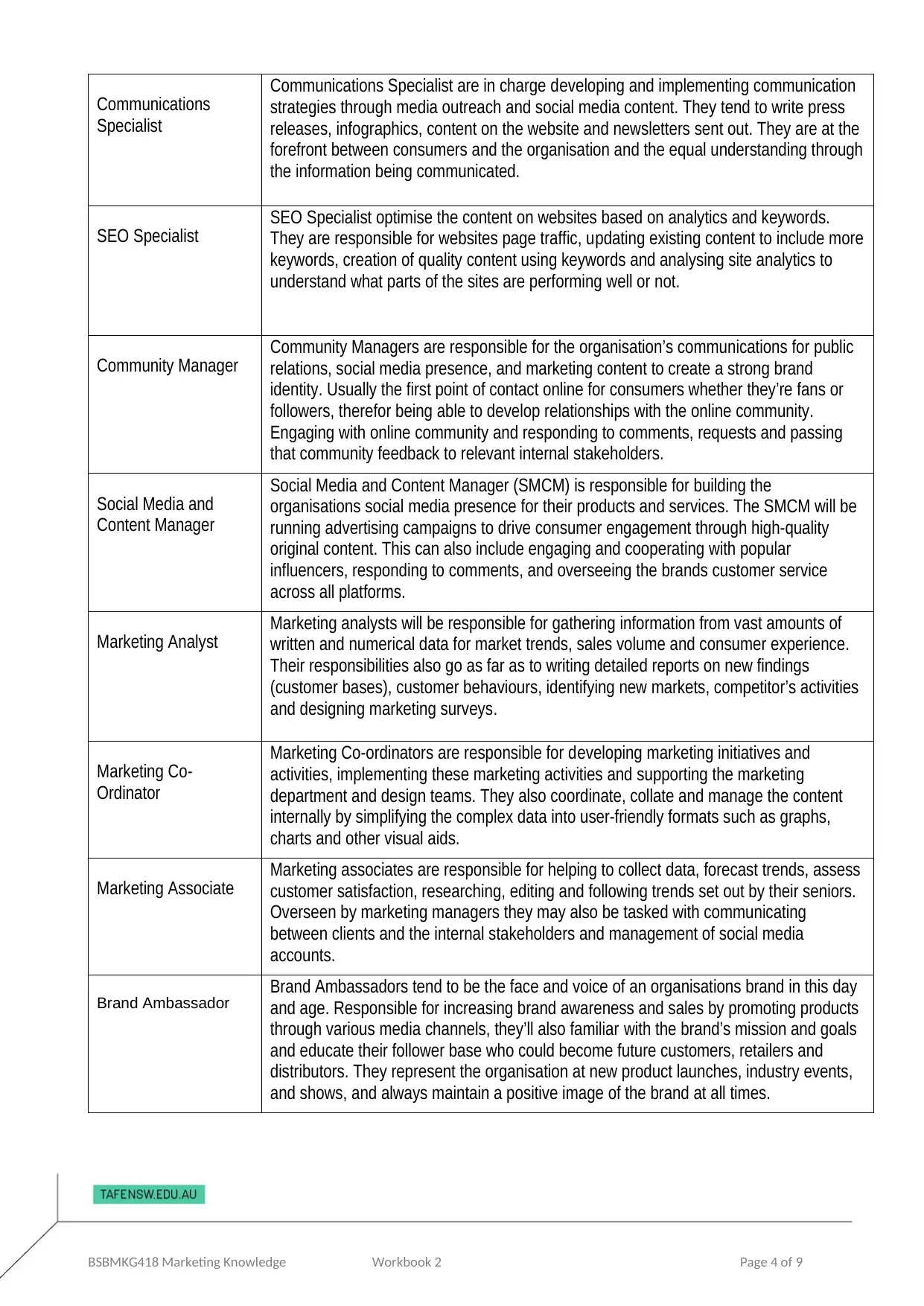
Communications
Specialist
Communications Specialist are in charge developing and implementing communication
strategies through media outreach and social media content. They tend to write press
releases, infographics, content on the website and newsletters sent out. They are at the
forefront between consumers and the organisation and the equal understanding through
the information being communicated.
SEO Specialist SEO Specialist optimise the content on websites based on analytics and keywords.
They are responsible for websites page traffic, updating existing content to include more
keywords, creation of quality content using keywords and analysing site analytics to
understand what parts of the sites are performing well or not.
Community Manager Community Managers are responsible for the organisation’s communications for public
relations, social media presence, and marketing content to create a strong brand
identity. Usually the first point of contact online for consumers whether they’re fans or
followers, therefor being able to develop relationships with the online community.
Engaging with online community and responding to comments, requests and passing
that community feedback to relevant internal stakeholders.
Social Media and
Content Manager
Social Media and Content Manager (SMCM) is responsible for building the
organisations social media presence for their products and services. The SMCM will be
running advertising campaigns to drive consumer engagement through high-quality
original content. This can also include engaging and cooperating with popular
influencers, responding to comments, and overseeing the brands customer service
across all platforms.
Marketing Analyst Marketing analysts will be responsible for gathering information from vast amounts of
written and numerical data for market trends, sales volume and consumer experience.
Their responsibilities also go as far as to writing detailed reports on new findings
(customer bases), customer behaviours, identifying new markets, competitor’s activities
and designing marketing surveys.
Marketing Co-
Ordinator
Marketing Co-ordinators are responsible for developing marketing initiatives and
activities, implementing these marketing activities and supporting the marketing
department and design teams. They also coordinate, collate and manage the content
internally by simplifying the complex data into user-friendly formats such as graphs,
charts and other visual aids.
Marketing Associate Marketing associates are responsible for helping to collect data, forecast trends, assess
customer satisfaction, researching, editing and following trends set out by their seniors.
Overseen by marketing managers they may also be tasked with communicating
between clients and the internal stakeholders and management of social media
accounts.
Brand Ambassador
Brand Ambassadors tend to be the face and voice of an organisations brand in this day
and age. Responsible for increasing brand awareness and sales by promoting products
through various media channels, they’ll also familiar with the brand’s mission and goals
and educate their follower base who could become future customers, retailers and
distributors. They represent the organisation at new product launches, industry events,
and shows, and always maintain a positive image of the brand at all times.
BSBMKG418 Marketing Knowledge Workbook 2 Page 4 of 9
Specialist
Communications Specialist are in charge developing and implementing communication
strategies through media outreach and social media content. They tend to write press
releases, infographics, content on the website and newsletters sent out. They are at the
forefront between consumers and the organisation and the equal understanding through
the information being communicated.
SEO Specialist SEO Specialist optimise the content on websites based on analytics and keywords.
They are responsible for websites page traffic, updating existing content to include more
keywords, creation of quality content using keywords and analysing site analytics to
understand what parts of the sites are performing well or not.
Community Manager Community Managers are responsible for the organisation’s communications for public
relations, social media presence, and marketing content to create a strong brand
identity. Usually the first point of contact online for consumers whether they’re fans or
followers, therefor being able to develop relationships with the online community.
Engaging with online community and responding to comments, requests and passing
that community feedback to relevant internal stakeholders.
Social Media and
Content Manager
Social Media and Content Manager (SMCM) is responsible for building the
organisations social media presence for their products and services. The SMCM will be
running advertising campaigns to drive consumer engagement through high-quality
original content. This can also include engaging and cooperating with popular
influencers, responding to comments, and overseeing the brands customer service
across all platforms.
Marketing Analyst Marketing analysts will be responsible for gathering information from vast amounts of
written and numerical data for market trends, sales volume and consumer experience.
Their responsibilities also go as far as to writing detailed reports on new findings
(customer bases), customer behaviours, identifying new markets, competitor’s activities
and designing marketing surveys.
Marketing Co-
Ordinator
Marketing Co-ordinators are responsible for developing marketing initiatives and
activities, implementing these marketing activities and supporting the marketing
department and design teams. They also coordinate, collate and manage the content
internally by simplifying the complex data into user-friendly formats such as graphs,
charts and other visual aids.
Marketing Associate Marketing associates are responsible for helping to collect data, forecast trends, assess
customer satisfaction, researching, editing and following trends set out by their seniors.
Overseen by marketing managers they may also be tasked with communicating
between clients and the internal stakeholders and management of social media
accounts.
Brand Ambassador
Brand Ambassadors tend to be the face and voice of an organisations brand in this day
and age. Responsible for increasing brand awareness and sales by promoting products
through various media channels, they’ll also familiar with the brand’s mission and goals
and educate their follower base who could become future customers, retailers and
distributors. They represent the organisation at new product launches, industry events,
and shows, and always maintain a positive image of the brand at all times.
BSBMKG418 Marketing Knowledge Workbook 2 Page 4 of 9
Paraphrase This Document
Need a fresh take? Get an instant paraphrase of this document with our AI Paraphraser
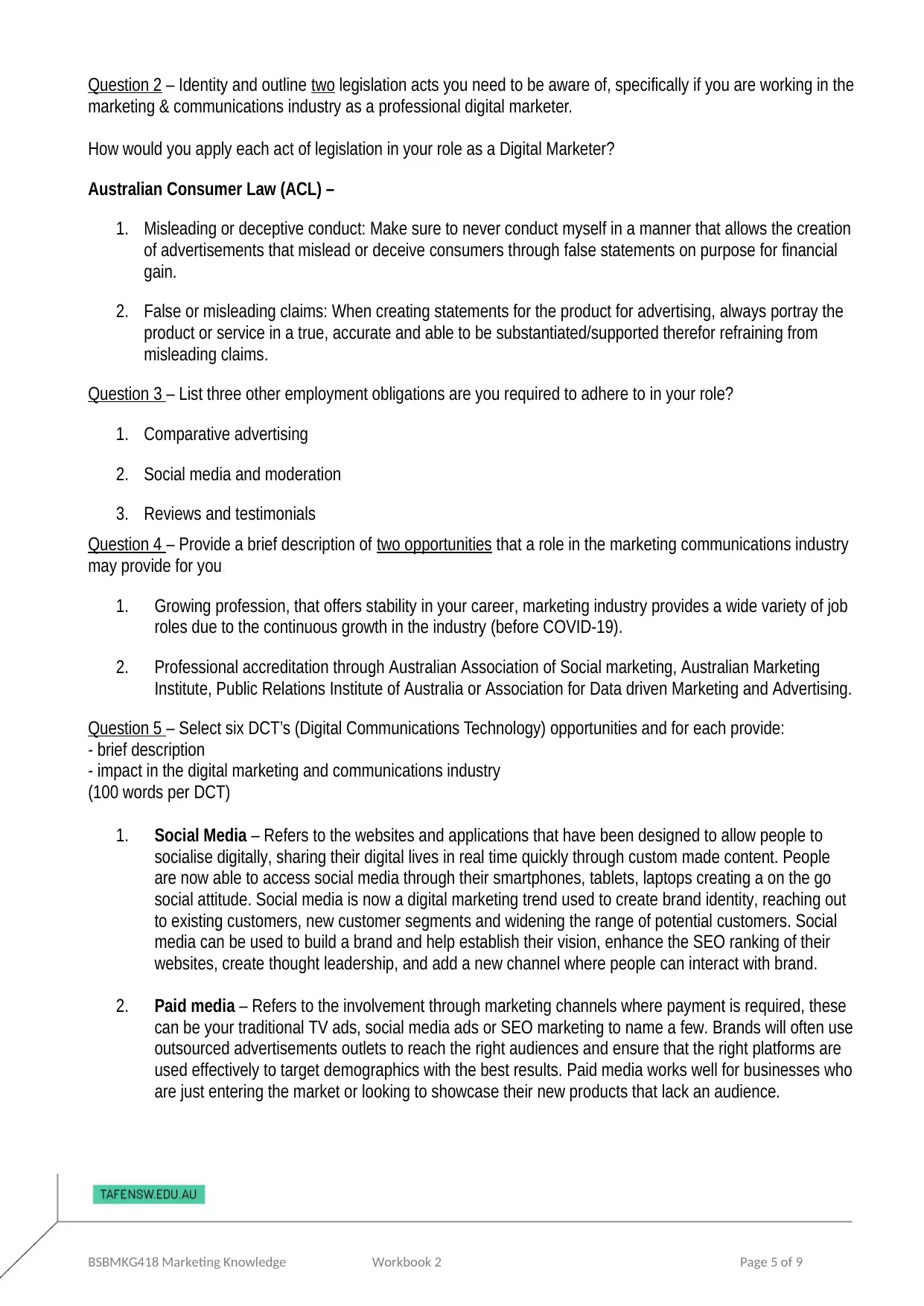
Question 2 – Identity and outline two legislation acts you need to be aware of, specifically if you are working in the
marketing & communications industry as a professional digital marketer.
How would you apply each act of legislation in your role as a Digital Marketer?
Australian Consumer Law (ACL) –
1. Misleading or deceptive conduct: Make sure to never conduct myself in a manner that allows the creation
of advertisements that mislead or deceive consumers through false statements on purpose for financial
gain.
2. False or misleading claims: When creating statements for the product for advertising, always portray the
product or service in a true, accurate and able to be substantiated/supported therefor refraining from
misleading claims.
Question 3 – List three other employment obligations are you required to adhere to in your role?
1. Comparative advertising
2. Social media and moderation
3. Reviews and testimonials
Question 4 – Provide a brief description of two opportunities that a role in the marketing communications industry
may provide for you.
1. Growing profession, that offers stability in your career, marketing industry provides a wide variety of job
roles due to the continuous growth in the industry (before COVID-19).
2. Professional accreditation through Australian Association of Social marketing, Australian Marketing
Institute, Public Relations Institute of Australia or Association for Data driven Marketing and Advertising.
Question 5 – Select six DCT’s (Digital Communications Technology) opportunities and for each provide:
- brief description
- impact in the digital marketing and communications industry
(100 words per DCT)
1. Social Media – Refers to the websites and applications that have been designed to allow people to
socialise digitally, sharing their digital lives in real time quickly through custom made content. People
are now able to access social media through their smartphones, tablets, laptops creating a on the go
social attitude. Social media is now a digital marketing trend used to create brand identity, reaching out
to existing customers, new customer segments and widening the range of potential customers. Social
media can be used to build a brand and help establish their vision, enhance the SEO ranking of their
websites, create thought leadership, and add a new channel where people can interact with brand.
a
2. Paid media – Refers to the involvement through marketing channels where payment is required, these
can be your traditional TV ads, social media ads or SEO marketing to name a few. Brands will often use
outsourced advertisements outlets to reach the right audiences and ensure that the right platforms are
used effectively to target demographics with the best results. Paid media works well for businesses who
are just entering the market or looking to showcase their new products that lack an audience.
a
BSBMKG418 Marketing Knowledge Workbook 2 Page 5 of 9
marketing & communications industry as a professional digital marketer.
How would you apply each act of legislation in your role as a Digital Marketer?
Australian Consumer Law (ACL) –
1. Misleading or deceptive conduct: Make sure to never conduct myself in a manner that allows the creation
of advertisements that mislead or deceive consumers through false statements on purpose for financial
gain.
2. False or misleading claims: When creating statements for the product for advertising, always portray the
product or service in a true, accurate and able to be substantiated/supported therefor refraining from
misleading claims.
Question 3 – List three other employment obligations are you required to adhere to in your role?
1. Comparative advertising
2. Social media and moderation
3. Reviews and testimonials
Question 4 – Provide a brief description of two opportunities that a role in the marketing communications industry
may provide for you.
1. Growing profession, that offers stability in your career, marketing industry provides a wide variety of job
roles due to the continuous growth in the industry (before COVID-19).
2. Professional accreditation through Australian Association of Social marketing, Australian Marketing
Institute, Public Relations Institute of Australia or Association for Data driven Marketing and Advertising.
Question 5 – Select six DCT’s (Digital Communications Technology) opportunities and for each provide:
- brief description
- impact in the digital marketing and communications industry
(100 words per DCT)
1. Social Media – Refers to the websites and applications that have been designed to allow people to
socialise digitally, sharing their digital lives in real time quickly through custom made content. People
are now able to access social media through their smartphones, tablets, laptops creating a on the go
social attitude. Social media is now a digital marketing trend used to create brand identity, reaching out
to existing customers, new customer segments and widening the range of potential customers. Social
media can be used to build a brand and help establish their vision, enhance the SEO ranking of their
websites, create thought leadership, and add a new channel where people can interact with brand.
a
2. Paid media – Refers to the involvement through marketing channels where payment is required, these
can be your traditional TV ads, social media ads or SEO marketing to name a few. Brands will often use
outsourced advertisements outlets to reach the right audiences and ensure that the right platforms are
used effectively to target demographics with the best results. Paid media works well for businesses who
are just entering the market or looking to showcase their new products that lack an audience.
a
BSBMKG418 Marketing Knowledge Workbook 2 Page 5 of 9
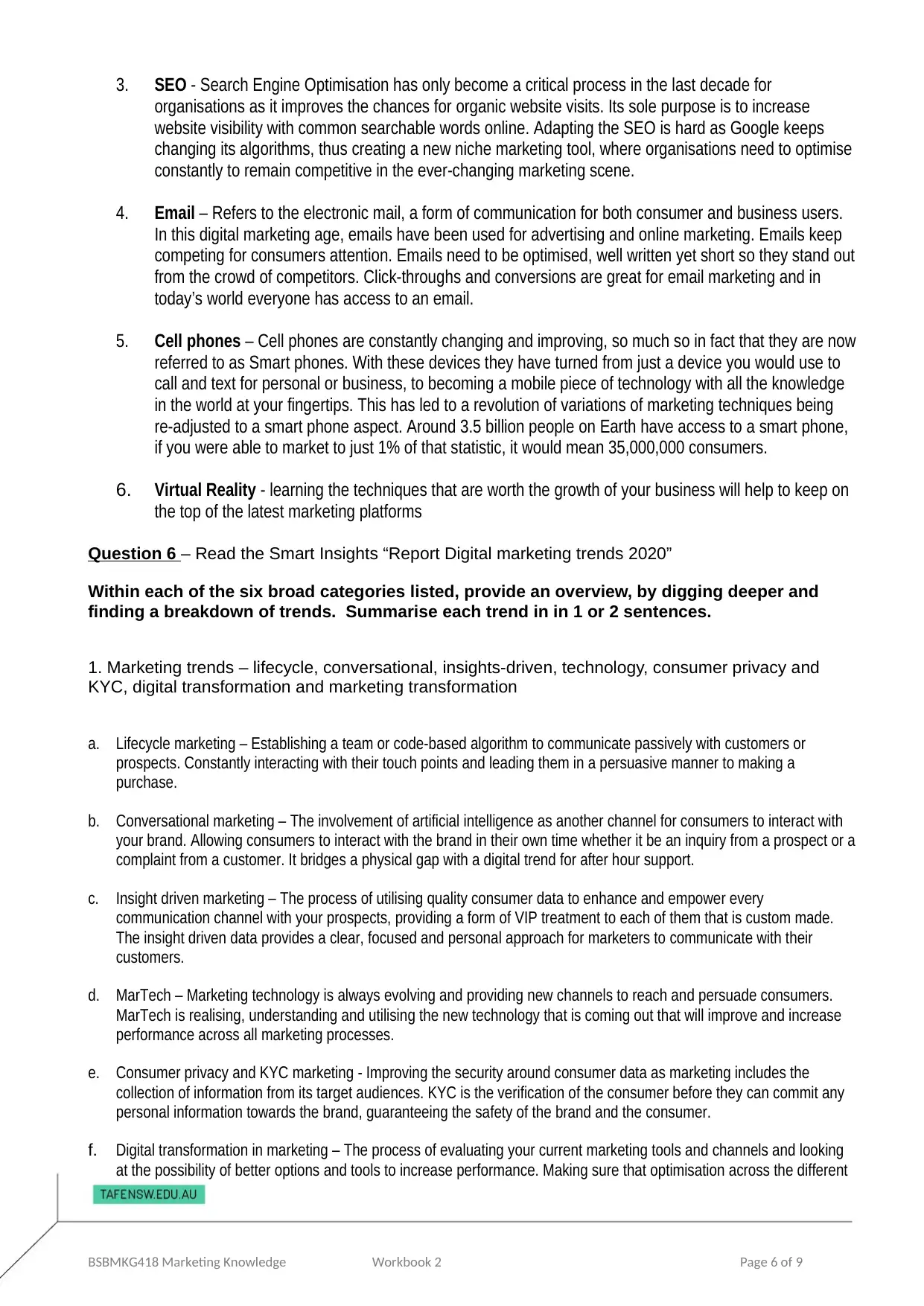
3. SEO - Search Engine Optimisation has only become a critical process in the last decade for
organisations as it improves the chances for organic website visits. Its sole purpose is to increase
website visibility with common searchable words online. Adapting the SEO is hard as Google keeps
changing its algorithms, thus creating a new niche marketing tool, where organisations need to optimise
constantly to remain competitive in the ever-changing marketing scene.
a
4. Email – Refers to the electronic mail, a form of communication for both consumer and business users.
In this digital marketing age, emails have been used for advertising and online marketing. Emails keep
competing for consumers attention. Emails need to be optimised, well written yet short so they stand out
from the crowd of competitors. Click-throughs and conversions are great for email marketing and in
today’s world everyone has access to an email. A
a
5. Cell phones – Cell phones are constantly changing and improving, so much so in fact that they are now
referred to as Smart phones. With these devices they have turned from just a device you would use to
call and text for personal or business, to becoming a mobile piece of technology with all the knowledge
in the world at your fingertips. This has led to a revolution of variations of marketing techniques being
re-adjusted to a smart phone aspect. Around 3.5 billion people on Earth have access to a smart phone,
if you were able to market to just 1% of that statistic, it would mean 35,000,000 consumers.
a
6. Virtual Reality - learning the techniques that are worth the growth of your business will help to keep on
the top of the latest marketing platforms
Question 6 – Read the Smart Insights “Report Digital marketing trends 2020”
Within each of the six broad categories listed, provide an overview, by digging deeper and
finding a breakdown of trends. Summarise each trend in in 1 or 2 sentences.
1. Marketing trends – lifecycle, conversational, insights-driven, technology, consumer privacy and
KYC, digital transformation and marketing transformation
a. Lifecycle marketing – Establishing a team or code-based algorithm to communicate passively with customers or
prospects. Constantly interacting with their touch points and leading them in a persuasive manner to making a
purchase.
b. Conversational marketing – The involvement of artificial intelligence as another channel for consumers to interact with
your brand. Allowing consumers to interact with the brand in their own time whether it be an inquiry from a prospect or a
complaint from a customer. It bridges a physical gap with a digital trend for after hour support.
c. Insight driven marketing – The process of utilising quality consumer data to enhance and empower every
communication channel with your prospects, providing a form of VIP treatment to each of them that is custom made.
The insight driven data provides a clear, focused and personal approach for marketers to communicate with their
customers.
d. MarTech – Marketing technology is always evolving and providing new channels to reach and persuade consumers.
MarTech is realising, understanding and utilising the new technology that is coming out that will improve and increase
performance across all marketing processes.
e. Consumer privacy and KYC marketing - Improving the security around consumer data as marketing includes the
collection of information from its target audiences. KYC is the verification of the consumer before they can commit any
personal information towards the brand, guaranteeing the safety of the brand and the consumer.
f. Digital transformation in marketing – The process of evaluating your current marketing tools and channels and looking
at the possibility of better options and tools to increase performance. Making sure that optimisation across the different
BSBMKG418 Marketing Knowledge Workbook 2 Page 6 of 9
organisations as it improves the chances for organic website visits. Its sole purpose is to increase
website visibility with common searchable words online. Adapting the SEO is hard as Google keeps
changing its algorithms, thus creating a new niche marketing tool, where organisations need to optimise
constantly to remain competitive in the ever-changing marketing scene.
a
4. Email – Refers to the electronic mail, a form of communication for both consumer and business users.
In this digital marketing age, emails have been used for advertising and online marketing. Emails keep
competing for consumers attention. Emails need to be optimised, well written yet short so they stand out
from the crowd of competitors. Click-throughs and conversions are great for email marketing and in
today’s world everyone has access to an email. A
a
5. Cell phones – Cell phones are constantly changing and improving, so much so in fact that they are now
referred to as Smart phones. With these devices they have turned from just a device you would use to
call and text for personal or business, to becoming a mobile piece of technology with all the knowledge
in the world at your fingertips. This has led to a revolution of variations of marketing techniques being
re-adjusted to a smart phone aspect. Around 3.5 billion people on Earth have access to a smart phone,
if you were able to market to just 1% of that statistic, it would mean 35,000,000 consumers.
a
6. Virtual Reality - learning the techniques that are worth the growth of your business will help to keep on
the top of the latest marketing platforms
Question 6 – Read the Smart Insights “Report Digital marketing trends 2020”
Within each of the six broad categories listed, provide an overview, by digging deeper and
finding a breakdown of trends. Summarise each trend in in 1 or 2 sentences.
1. Marketing trends – lifecycle, conversational, insights-driven, technology, consumer privacy and
KYC, digital transformation and marketing transformation
a. Lifecycle marketing – Establishing a team or code-based algorithm to communicate passively with customers or
prospects. Constantly interacting with their touch points and leading them in a persuasive manner to making a
purchase.
b. Conversational marketing – The involvement of artificial intelligence as another channel for consumers to interact with
your brand. Allowing consumers to interact with the brand in their own time whether it be an inquiry from a prospect or a
complaint from a customer. It bridges a physical gap with a digital trend for after hour support.
c. Insight driven marketing – The process of utilising quality consumer data to enhance and empower every
communication channel with your prospects, providing a form of VIP treatment to each of them that is custom made.
The insight driven data provides a clear, focused and personal approach for marketers to communicate with their
customers.
d. MarTech – Marketing technology is always evolving and providing new channels to reach and persuade consumers.
MarTech is realising, understanding and utilising the new technology that is coming out that will improve and increase
performance across all marketing processes.
e. Consumer privacy and KYC marketing - Improving the security around consumer data as marketing includes the
collection of information from its target audiences. KYC is the verification of the consumer before they can commit any
personal information towards the brand, guaranteeing the safety of the brand and the consumer.
f. Digital transformation in marketing – The process of evaluating your current marketing tools and channels and looking
at the possibility of better options and tools to increase performance. Making sure that optimisation across the different
BSBMKG418 Marketing Knowledge Workbook 2 Page 6 of 9
⊘ This is a preview!⊘
Do you want full access?
Subscribe today to unlock all pages.

Trusted by 1+ million students worldwide
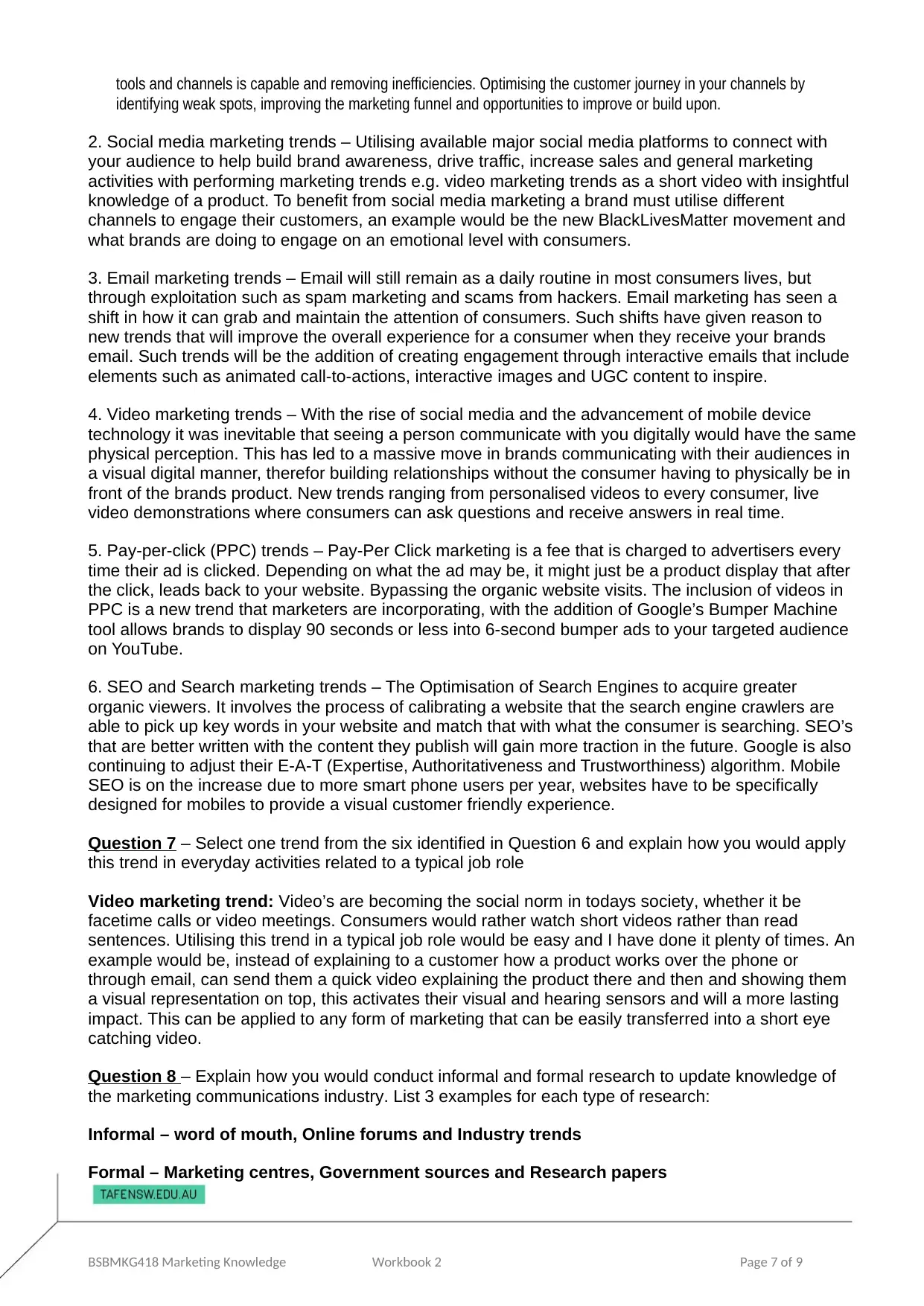
tools and channels is capable and removing inefficiencies. Optimising the customer journey in your channels by
identifying weak spots, improving the marketing funnel and opportunities to improve or build upon.
2. Social media marketing trends – Utilising available major social media platforms to connect with
your audience to help build brand awareness, drive traffic, increase sales and general marketing
activities with performing marketing trends e.g. video marketing trends as a short video with insightful
knowledge of a product. To benefit from social media marketing a brand must utilise different
channels to engage their customers, an example would be the new BlackLivesMatter movement and
what brands are doing to engage on an emotional level with consumers.
3. Email marketing trends – Email will still remain as a daily routine in most consumers lives, but
through exploitation such as spam marketing and scams from hackers. Email marketing has seen a
shift in how it can grab and maintain the attention of consumers. Such shifts have given reason to
new trends that will improve the overall experience for a consumer when they receive your brands
email. Such trends will be the addition of creating engagement through interactive emails that include
elements such as animated call-to-actions, interactive images and UGC content to inspire.
4. Video marketing trends – With the rise of social media and the advancement of mobile device
technology it was inevitable that seeing a person communicate with you digitally would have the same
physical perception. This has led to a massive move in brands communicating with their audiences in
a visual digital manner, therefor building relationships without the consumer having to physically be in
front of the brands product. New trends ranging from personalised videos to every consumer, live
video demonstrations where consumers can ask questions and receive answers in real time.
5. Pay-per-click (PPC) trends – Pay-Per Click marketing is a fee that is charged to advertisers every
time their ad is clicked. Depending on what the ad may be, it might just be a product display that after
the click, leads back to your website. Bypassing the organic website visits. The inclusion of videos in
PPC is a new trend that marketers are incorporating, with the addition of Google’s Bumper Machine
tool allows brands to display 90 seconds or less into 6-second bumper ads to your targeted audience
on YouTube.
6. SEO and Search marketing trends – The Optimisation of Search Engines to acquire greater
organic viewers. It involves the process of calibrating a website that the search engine crawlers are
able to pick up key words in your website and match that with what the consumer is searching. SEO’s
that are better written with the content they publish will gain more traction in the future. Google is also
continuing to adjust their E-A-T (Expertise, Authoritativeness and Trustworthiness) algorithm. Mobile
SEO is on the increase due to more smart phone users per year, websites have to be specifically
designed for mobiles to provide a visual customer friendly experience.
Question 7 – Select one trend from the six identified in Question 6 and explain how you would apply
this trend in everyday activities related to a typical job role
Video marketing trend: Video’s are becoming the social norm in todays society, whether it be
facetime calls or video meetings. Consumers would rather watch short videos rather than read
sentences. Utilising this trend in a typical job role would be easy and I have done it plenty of times. An
example would be, instead of explaining to a customer how a product works over the phone or
through email, can send them a quick video explaining the product there and then and showing them
a visual representation on top, this activates their visual and hearing sensors and will a more lasting
impact. This can be applied to any form of marketing that can be easily transferred into a short eye
catching video.
Question 8 – Explain how you would conduct informal and formal research to update knowledge of
the marketing communications industry. List 3 examples for each type of research:
Informal – word of mouth, Online forums and Industry trends
Formal – Marketing centres, Government sources and Research papers
BSBMKG418 Marketing Knowledge Workbook 2 Page 7 of 9
identifying weak spots, improving the marketing funnel and opportunities to improve or build upon.
2. Social media marketing trends – Utilising available major social media platforms to connect with
your audience to help build brand awareness, drive traffic, increase sales and general marketing
activities with performing marketing trends e.g. video marketing trends as a short video with insightful
knowledge of a product. To benefit from social media marketing a brand must utilise different
channels to engage their customers, an example would be the new BlackLivesMatter movement and
what brands are doing to engage on an emotional level with consumers.
3. Email marketing trends – Email will still remain as a daily routine in most consumers lives, but
through exploitation such as spam marketing and scams from hackers. Email marketing has seen a
shift in how it can grab and maintain the attention of consumers. Such shifts have given reason to
new trends that will improve the overall experience for a consumer when they receive your brands
email. Such trends will be the addition of creating engagement through interactive emails that include
elements such as animated call-to-actions, interactive images and UGC content to inspire.
4. Video marketing trends – With the rise of social media and the advancement of mobile device
technology it was inevitable that seeing a person communicate with you digitally would have the same
physical perception. This has led to a massive move in brands communicating with their audiences in
a visual digital manner, therefor building relationships without the consumer having to physically be in
front of the brands product. New trends ranging from personalised videos to every consumer, live
video demonstrations where consumers can ask questions and receive answers in real time.
5. Pay-per-click (PPC) trends – Pay-Per Click marketing is a fee that is charged to advertisers every
time their ad is clicked. Depending on what the ad may be, it might just be a product display that after
the click, leads back to your website. Bypassing the organic website visits. The inclusion of videos in
PPC is a new trend that marketers are incorporating, with the addition of Google’s Bumper Machine
tool allows brands to display 90 seconds or less into 6-second bumper ads to your targeted audience
on YouTube.
6. SEO and Search marketing trends – The Optimisation of Search Engines to acquire greater
organic viewers. It involves the process of calibrating a website that the search engine crawlers are
able to pick up key words in your website and match that with what the consumer is searching. SEO’s
that are better written with the content they publish will gain more traction in the future. Google is also
continuing to adjust their E-A-T (Expertise, Authoritativeness and Trustworthiness) algorithm. Mobile
SEO is on the increase due to more smart phone users per year, websites have to be specifically
designed for mobiles to provide a visual customer friendly experience.
Question 7 – Select one trend from the six identified in Question 6 and explain how you would apply
this trend in everyday activities related to a typical job role
Video marketing trend: Video’s are becoming the social norm in todays society, whether it be
facetime calls or video meetings. Consumers would rather watch short videos rather than read
sentences. Utilising this trend in a typical job role would be easy and I have done it plenty of times. An
example would be, instead of explaining to a customer how a product works over the phone or
through email, can send them a quick video explaining the product there and then and showing them
a visual representation on top, this activates their visual and hearing sensors and will a more lasting
impact. This can be applied to any form of marketing that can be easily transferred into a short eye
catching video.
Question 8 – Explain how you would conduct informal and formal research to update knowledge of
the marketing communications industry. List 3 examples for each type of research:
Informal – word of mouth, Online forums and Industry trends
Formal – Marketing centres, Government sources and Research papers
BSBMKG418 Marketing Knowledge Workbook 2 Page 7 of 9
Paraphrase This Document
Need a fresh take? Get an instant paraphrase of this document with our AI Paraphraser
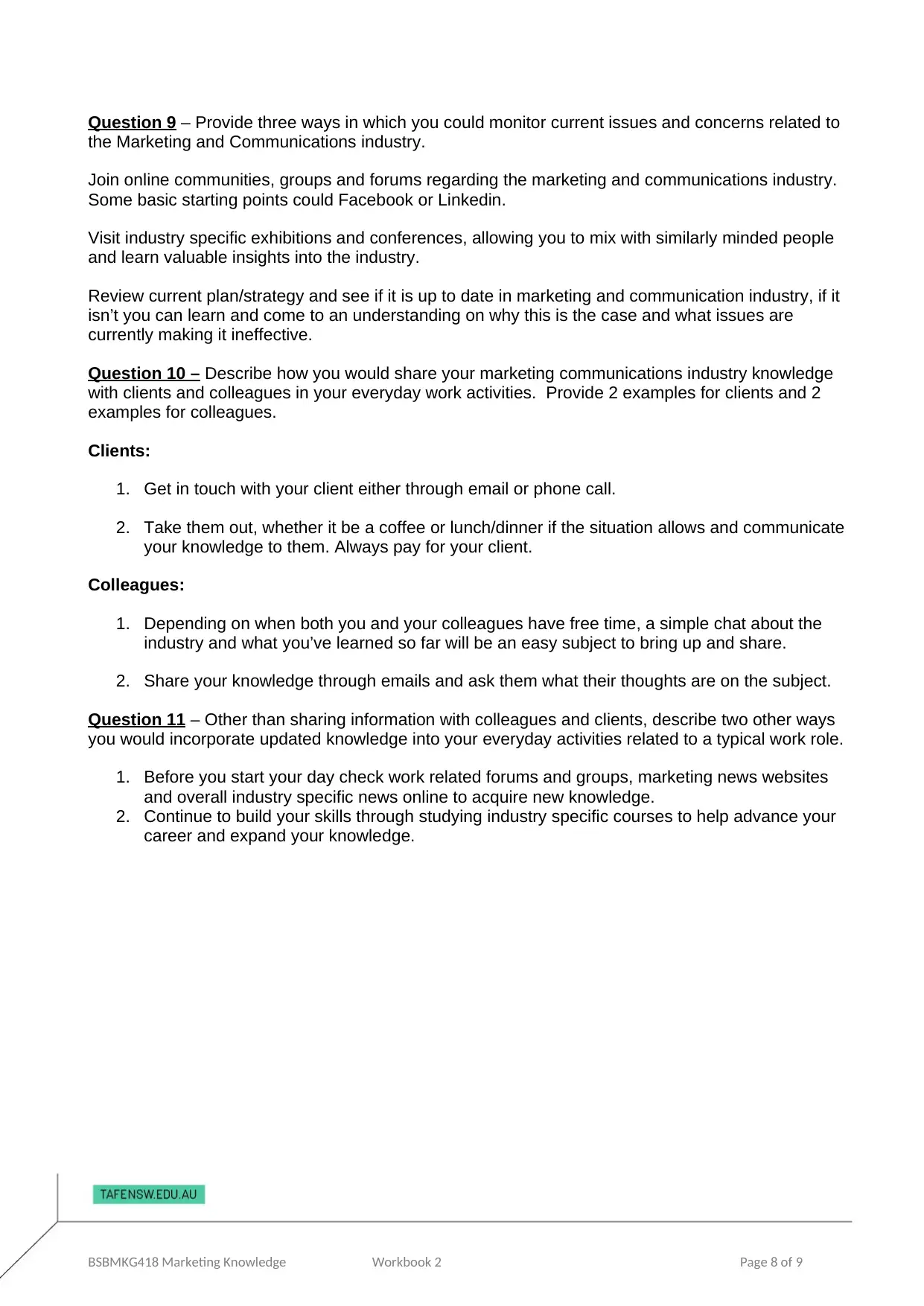
Question 9 – Provide three ways in which you could monitor current issues and concerns related to
the Marketing and Communications industry.
Join online communities, groups and forums regarding the marketing and communications industry.
Some basic starting points could Facebook or Linkedin.
Visit industry specific exhibitions and conferences, allowing you to mix with similarly minded people
and learn valuable insights into the industry.
Review current plan/strategy and see if it is up to date in marketing and communication industry, if it
isn’t you can learn and come to an understanding on why this is the case and what issues are
currently making it ineffective.
Question 10 – Describe how you would share your marketing communications industry knowledge
with clients and colleagues in your everyday work activities. Provide 2 examples for clients and 2
examples for colleagues.
Clients:
1. Get in touch with your client either through email or phone call.
2. Take them out, whether it be a coffee or lunch/dinner if the situation allows and communicate
your knowledge to them. Always pay for your client.
Colleagues:
1. Depending on when both you and your colleagues have free time, a simple chat about the
industry and what you’ve learned so far will be an easy subject to bring up and share.
2. Share your knowledge through emails and ask them what their thoughts are on the subject.
Question 11 – Other than sharing information with colleagues and clients, describe two other ways
you would incorporate updated knowledge into your everyday activities related to a typical work role.
1. Before you start your day check work related forums and groups, marketing news websites
and overall industry specific news online to acquire new knowledge.
2. Continue to build your skills through studying industry specific courses to help advance your
career and expand your knowledge.
BSBMKG418 Marketing Knowledge Workbook 2 Page 8 of 9
the Marketing and Communications industry.
Join online communities, groups and forums regarding the marketing and communications industry.
Some basic starting points could Facebook or Linkedin.
Visit industry specific exhibitions and conferences, allowing you to mix with similarly minded people
and learn valuable insights into the industry.
Review current plan/strategy and see if it is up to date in marketing and communication industry, if it
isn’t you can learn and come to an understanding on why this is the case and what issues are
currently making it ineffective.
Question 10 – Describe how you would share your marketing communications industry knowledge
with clients and colleagues in your everyday work activities. Provide 2 examples for clients and 2
examples for colleagues.
Clients:
1. Get in touch with your client either through email or phone call.
2. Take them out, whether it be a coffee or lunch/dinner if the situation allows and communicate
your knowledge to them. Always pay for your client.
Colleagues:
1. Depending on when both you and your colleagues have free time, a simple chat about the
industry and what you’ve learned so far will be an easy subject to bring up and share.
2. Share your knowledge through emails and ask them what their thoughts are on the subject.
Question 11 – Other than sharing information with colleagues and clients, describe two other ways
you would incorporate updated knowledge into your everyday activities related to a typical work role.
1. Before you start your day check work related forums and groups, marketing news websites
and overall industry specific news online to acquire new knowledge.
2. Continue to build your skills through studying industry specific courses to help advance your
career and expand your knowledge.
BSBMKG418 Marketing Knowledge Workbook 2 Page 8 of 9

Page 9 of 9
⊘ This is a preview!⊘
Do you want full access?
Subscribe today to unlock all pages.

Trusted by 1+ million students worldwide
1 out of 9
Related Documents
Your All-in-One AI-Powered Toolkit for Academic Success.
+13062052269
info@desklib.com
Available 24*7 on WhatsApp / Email
![[object Object]](/_next/static/media/star-bottom.7253800d.svg)
Unlock your academic potential
Copyright © 2020–2025 A2Z Services. All Rights Reserved. Developed and managed by ZUCOL.





